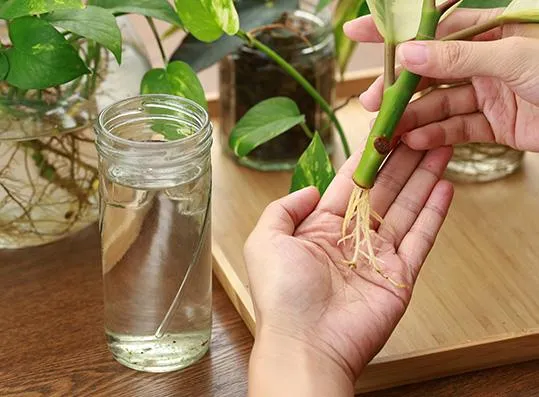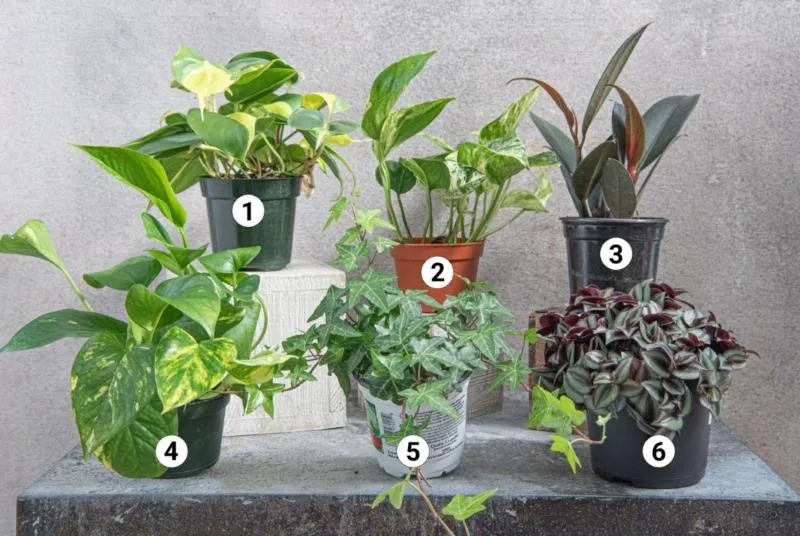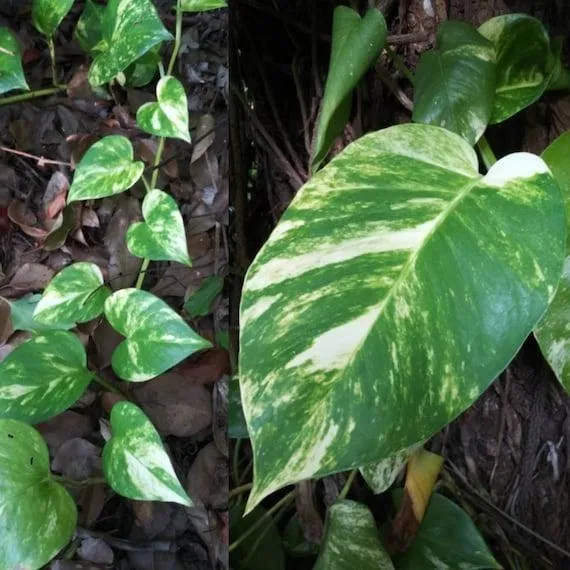Everything You Need to Know About Rooting Ivy Cuttings in Water
If you’ve got ivy growing in your home or garden and want to propagate more plants from cuttings, rooting ivy in water is a simple and effective method. In this article, I’ll cover the whole process from collecting cuttings to potting up rooted cuttings. By the end, you’ll have everything you need to root ivy successfully.
Choosing Cuttings
- Take stem cuttings in the spring or summer when new growth is abundant.
- Cut stems 6-12 inches long from non-flowering, well-established ivy vines.
- Use a pruner or sharp knife to make a clean cut just below a node (the leaf attachment point).
Aim for green, flexible new growth. From my experience, cuttings with at least 3-4 nodes have the highest rooting success. Remove leaves from the bottom 1-2 inches to reduce transpiration while rooting.
Preparing the Water
Use clean, room temperature water without any added chemicals or fertilizers. Hard water can inhibit rooting, so consider using distilled or rain water if you have high mineral content tap water. Change the water at least every 5-7 days to prevent algae buildup and provide nutrients for new roots.
Rooting Method
There are two main methods for rooting ivy cuttings in water: the test tube method and the vase method.
Test Tube Method:
Insert cuttings straight down into clean test tubes filled with water. Place test tubes in a bright, warm area and watch for roots to form in 1-4 weeks. This method works well for cuttings with few roots but provides less oxygen to roots than the vase method.

Vase Method:
Stand cuttings at an angle with bottoms 1-2 inches deep in a vase of water. I’ve found putting marbles or pebbles in the bottom helps hold stems steady until roots form. Change water weekly. Roots generally form faster using this method due to improved oxygen circulation around roots for enhanced growth.
Rooting Conditions
Provide optimal rooting conditions of bright, indirect light and warm temperatures between 65-80°F. Southern or eastern windows usually work well. Feel the bottom of cuttings daily – when they are firm with white root buds growing, they’re ready for potting up. Propagating ivy cuttings is usually a 2-4 week process depending on conditions.
Potting Up Rooted Cuttings
When cuttings have formed a good root system 1⁄4 to 1⁄2 inch long, it’s time to pot them up in soil.
- Use a well-draining potting mix without fertilizer, which can burn new roots.
- Gently remove cutting from water and tease out any root tangling with your fingers.
- Position cutting slightly deeper than it was rooted to encourage more root growth outward from the stem.
- Mist soil and place pot in partial shade until roots are established, about 2-4 weeks.
Monitor soil moisture and move plants gradually to brighter light as they acclimate. Within a few months, rooted cuttings will be filling out and ready for their permanent spot!
Potential Problems
The main issue with rooting ivy cuttings is rot. Too much shade, cold temperatures, or stale water can all cause cuttings to rot before roots form. Signs are brown leaves or stems that feel mushy.

Removing spent flowers and preventing infestations can reduce disease issues. Aphids sometimes appear on new growth – simply rinse plants with water or use neem oil or insecticidal soap. With the right conditions, rooting ivy cuttings in water has a success rate of 60-80%!
Alternative Methods
If you want to skip the water propagation step, you can also root ivy cuttings directly in soil. Use a warm, humid rooting chamber like a clear plastic bag placed over potted cuttings in partial shade. Check soil moisture daily and mist foliage. Roots may form a little slower this way, but it works well too. You can even root some cuttings in water and some directly in soil to compare methods.
From my experience, once rooted ivy cuttings are established, they grow like weeds! In a year, you’ll have an abundance of new ivy plants to use in hanging baskets, as groundcover, or to share with friends. The process of rooting new plants from cuttings is basically like cloning – giving new life to a plant you already love growing. It’s rewarding and helps propagate favorite garden vines economically. Give rooting ivy cuttings in water a try – you’ll be amazed by the results!
Let me know if you have any other questions! I’d be happy to share more tips for propagating plants from stem cuttings. With a little patience, it’s easy to multiply your ivy collection through rooting cuttings in water. Give it a shot – you’ve got nothing to lose and new plants to gain.
Tips for Rooting Ivy Cuttings in Water
| Cutting Length | 3-5 inches long |
|---|---|
| Cutting Material | Use fresh, healthy stems without any spots or damage |
| Water Type | Use filtered or distilled water to avoid minerals that could slow growth |
| Water Change | Change water every 5-7 days to provide nutrients and oxygen to roots |
| Light | Place in indirect sunlight and maintain warmth above 60°F for best rooting |
| Root Development | Roots may take 2-6 weeks to develop depending on plant variety and growing conditions |
| Transplanting | Move cuttings to soil once roots have developed at least 1 inch in length |
FAQ
-
How do I get started rooting ivy cuttings in water?
Basically, it’s pretty simple. You’ll just need some ivy cuttings and a glass of water. Take cuttings that are a few inches long and remove the bottom leaves. Then stick the cuttings almost all the way into the water – like 90% under. Place the glass in bright, indirect light. That’s pretty much it! The cuttings should start growing roots in a few weeks.

-
Do the cuttings need to be a certain size?
While you can root really short cuttings, it’s better if they’re at least 3 inches long. The longer the cutting, the more likely it is to grow roots. Cut just below a leaf node. Perhaps larger cuttings also have more stored energy to fuel root growth. So to be on the safe side, go for cuttings that are 3 to 6 inches long if possible.
-
How often do I need to change the water?
You’ll want to switch out the water every 5 to 7 days. Standing water can get gross and harbor bacteria. At the same time, it’s important not to disturb the roots too much when you change it. So some people just top it off with fresh water instead of dumping the whole thing. Either way works as long as the water stays pretty clean.
-
When will the cuttings start growing roots?
Most cuttings will take about 2 to 4 weeks to send out their first tiny roots. However, some may be real slowpokes and take 6 weeks or more. Amazingly, a few cuttings have even rooted for me after just 10 days! Generally, the brighter the light and warmer the temperature, the faster it’ll happen. But patience is key with plant propagation. You just have to wait for nature to take its course.
-
How do I know when the cuttings are ready to plant?
You’ll see little white root buds start to form at the bottom of the stem under the water. Once the roots are about 1/2 inch long or more, the cuttings are ready for soil. You can also gently pull on the roots – if they resist and stay attached, it’s rooting time! Transfer the rooted cuttings to pots with a well-draining soil and keep the soil moist until they’re established.
-
What’s the success rate for rooting ivy cuttings in water?
Most sources say the success rate is around 70-80% with water propagation. However, that’s just a rough estimate – your mileage may vary. Factors like lighting, temperature and the health of the parent plant can influence it. I’ve had batches where only 50% took, yet others where nearly all of them rooted. So as long as you follow the basic instructions, the vast majority should take. You just need to hope Lady Luck is smiling down on your cuttings!

-
Can I speed up the rooting process with anything else?
Some people claim using rooting hormone powder on the stems helps, but I’ve never noticed a big difference personally. Keeping the water warm around 70-75F using a heat mat under the glass might possibly help roots form a bit faster too. You could also try a moist rooting media like perlite or vermiculite instead of just water alone. But honestly, the water method works great on its own most of the time.
